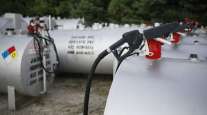Diesel, Gasoline Prices Dip for Sixth Consecutive Week
This story appears in the April 15 print edition of Transport Topics.
U.S. retail diesel and gasoline prices continued to drift down from their winter highs, with both refined products declining for a sixth straight week, the Department of Energy reported.
Diesel dipped by 1.6 cents a gallon to an average of $3.977 on April 8. The cumulative total of the six weekly declines in the national figure is 18.2 cents, or 4.4% off the Feb. 25 peak of $4.159 — the 12-month high.
A year ago the average stood at $4.148, while the 12-month low was $3.648 on July 2.
DOE’s Energy Information Administration also said that gasoline dropped 3.7 cents a gallon to $3.608. The combined total for the gas price decline is 17.6 cents, or 4.7% off the year-to-date high of $3.784. A year ago the gas average was $3.939 and the 12-month low was $3.254 on Dec. 17.
Crude oil futures prices on the New York Mercantile Exchange remained stable last week, closing between $92 and $95 a barrel, before settling at $93.51 on April 11.
Analysts said petroleum markets are in stable equilibrium now, with no obvious reasons for prices to surge or plummet.
“We’re meandering now, not trending” up or down, said Bruce Gress, director of petroleum risk management for the Pilot Flying J truck stop chain.
A spokesman for UPS Inc. told Transport Topics editors and reporters that the decline in petroleum prices is “obviously a good thing,” especially since fuel surcharges can catch up after falling behind in the January-February price surge, but that North America’s largest freight transportation company can never stop obsessing over the cost of the diesel, jet fuel and gasoline it buys worldwide.
“We look at everything on fuel. It’s almost religious for us,” said UPS’ Dan McMackin. The company’s global surface fleet racks up more than 2 billion miles a year.
Among the company’s projects to ameliorate high fuel prices is the new Orion program, or on-road integrated optimization and navigation. McMackin said UPS employs a team of mathematicians in Timonium, Md., to write route-optimization software.
“It’s about 50% rolled out and it reorders delivery directions after each delivery. It’s a sea change for delivery,” he said, adding that Orion will be featured in an episode of “Nova” dealing with optimization on PBS later this year.
UPS also has fuel-optimization software for its fleet of about 560 aircraft for express delivery that reduces idling on the ground and moves from peak altitude to landing more smoothly.
For one of the nation’s small fleets, the retreat in diesel prices has not corrected all problems.
“Oil price increases hit parts and tires, too,” said Larry Limp, president of LNL Trucking in Bedford, Ind. Limp said that since the fuel price spike in 2008, his tire costs have increased by more than 60% because of the oil that goes into synthetic rubber.
LNL’s five power units haul tanks of vegetable oils and animal fats east of the Mississippi River, with each rig moving about 2,600 miles a week.
Limp said he has governed the top speed for his trucks’ engines and coached drivers to cruise in the rpm “sweet spot” for maximum efficiency.
“We track fuel economy and look for changes week to week,” Limp said.
EIA said April 9 in its Short-Term Energy Outlook that it is keeping its diesel-price forecast at $3.90 a gallon this year and that trucking’s main fuel will average $3.80 in 2014.
Nymex crude, which averaged $94.12 a barrel last year, will average $92.25 a barrel in 2014, EIA projected.
On April 10, Bloomberg News reported that a Saudi Arabian oil ministry official said during an Opec meeting in Kuwait that “oil markets will be balanced this year with Brent crude at about $100 a barrel.” Crude prices on the London market have declined to about $106 a barrel recently after nearing $119 on Feb. 8.
The Saudi assessment reiterates a statement from that government in March that $100 is a “reasonable” price for oil, Bloomberg said.




